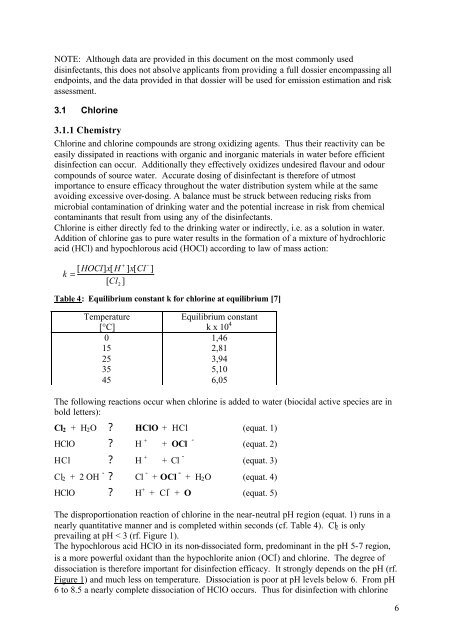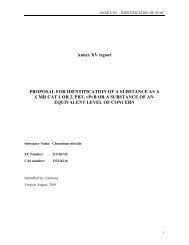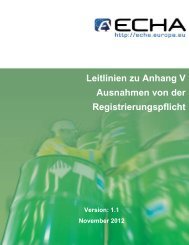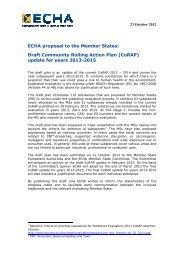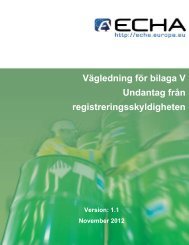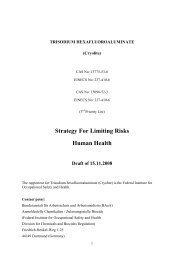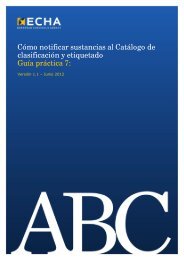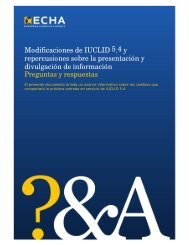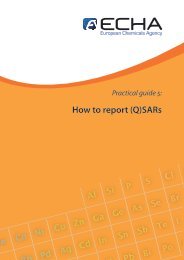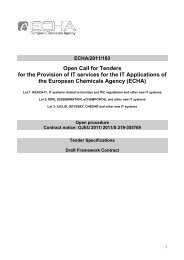EUBEES - ECHA - Europa
EUBEES - ECHA - Europa
EUBEES - ECHA - Europa
Create successful ePaper yourself
Turn your PDF publications into a flip-book with our unique Google optimized e-Paper software.
NOTE: Although data are provided in this document on the most commonly used<br />
disinfectants, this does not absolve applicants from providing a full dossier encompassing all<br />
endpoints, and the data provided in that dossier will be used for emission estimation and risk<br />
assessment.<br />
3.1 Chlorine<br />
3.1.1 Chemistry<br />
Chlorine and chlorine compounds are strong oxidizing agents. Thus their reactivity can be<br />
easily dissipated in reactions with organic and inorganic materials in water before efficient<br />
disinfection can occur. Additionally they effectively oxidizes undesired flavour and odour<br />
compounds of source water. Accurate dosing of disinfectant is therefore of utmost<br />
importance to ensure efficacy throughout the water distribution system while at the same<br />
avoiding excessive over-dosing. A balance must be struck between reducing risks from<br />
microbial contamination of drinking water and the potential increase in risk from chemical<br />
contaminants that result from using any of the disinfectants.<br />
Chlorine is either directly fed to the drinking water or indirectly, i.e. as a solution in water.<br />
Addition of chlorine gas to pure water results in the formation of a mixture of hydrochloric<br />
acid (HCl) and hypochlorous acid (HOCl) according to law of mass action:<br />
+ −<br />
[ HOCl]<br />
x[<br />
H ] x[<br />
Cl ]<br />
k =<br />
[ Cl 2<br />
]<br />
Table 4: Equilibrium constant k for chlorine at equilibrium [7]<br />
Temperature<br />
[°C]<br />
0<br />
15<br />
25<br />
35<br />
45<br />
Equilibrium constant<br />
k x 10 4<br />
1,46<br />
2,81<br />
3,94<br />
5,10<br />
6,05<br />
The following reactions occur when chlorine is added to water (biocidal active species are in<br />
bold letters):<br />
Cl 2 + H 2 O ? HClO + HCl (equat. 1)<br />
HClO ? H + + OCl - (equat. 2)<br />
HCl ? H + + Cl - (equat. 3)<br />
Cl 2 + 2 OH - ? Cl - + OCl - + H 2 O (equat. 4)<br />
HClO ? H + + Cl - + O (equat. 5)<br />
The disproportionation reaction of chlorine in the near-neutral pH region (equat. 1) runs in a<br />
nearly quantitative manner and is completed within seconds (cf. Table 4). Cl 2 is only<br />
prevailing at pH < 3 (rf. Figure 1).<br />
The hypochlorous acid HClO in its non-dissociated form, predominant in the pH 5-7 region,<br />
is a more powerful oxidant than the hypochlorite anion (OCl - ) and chlorine. The degree of<br />
dissociation is therefore important for disinfection efficacy. It strongly depends on the pH (rf.<br />
Figure 1) and much less on temperature. Dissociation is poor at pH levels below 6. From pH<br />
6 to 8.5 a nearly complete dissociation of HClO occurs. Thus for disinfection with chlorine<br />
6


